Selecting the correct poster size is a foundational step in designing effective visual content. Whether you’re promoting an event, advertising a product, or showcasing artwork, the dimensions of your poster can significantly impact its success. Larger posters offer more space for detailed imagery and extensive information, while smaller ones require concise, focused content. Understanding the standard poster sizes and how to use them will help you make the right choice for your specific needs.
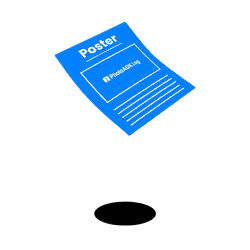
1000+ Pre-designed Poster Templates from PhotoADKing
Discover stunning poster templates! Transform your message with eye-catching designs that leave a lasting impression.
Explore Poster Templates!Global Standard Poster Sizes Explained
Poster sizes are standardized across the globe, making it easier to design and print posters for various purposes. The most commonly used poster sizes are part of the A-series, which includes A0, A1, A2, A3, A4, and A5. These sizes are derived from the ISO 216 standard, which defines international paper sizes based on the square root of two (1:√2) aspect ratio. This ratio ensures that each subsequent size is half the area of the previous one.
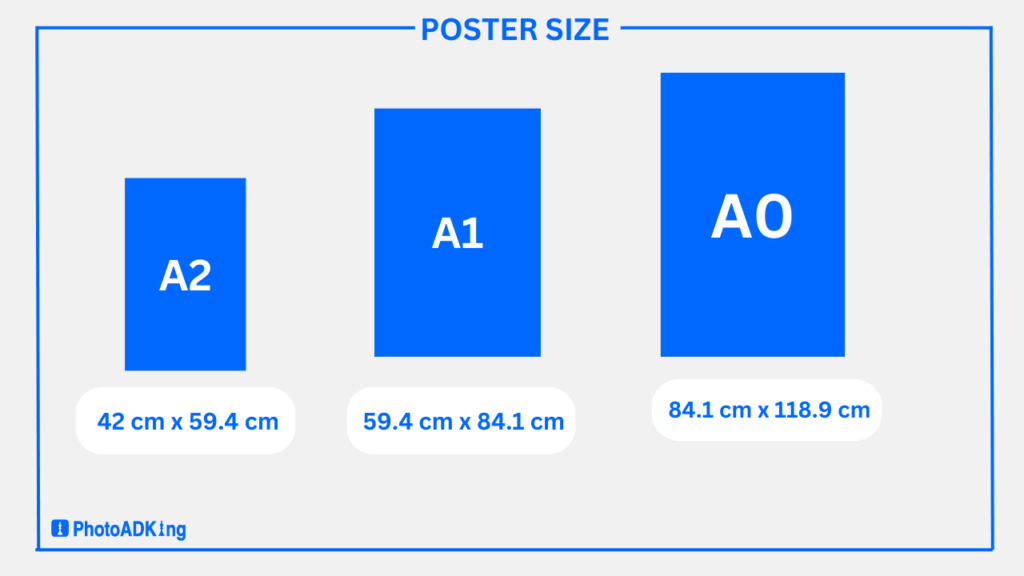
| Poster Size | Size In Pixle | Size in cm | Size in mm | Size in Inches |
| A0 | 9933 x 14043 | 84.1 x 118.9 cm | 841 x 1189 mm | 33.1 x 46.8in |
| A1 | 7016 x 9933 | 59.4 x 84.1 cm | 594 x 841 mm | 23.4 x 33.1in |
| A2 | 4961 x 7016 | 42 x 59.4 cm | 420 x 594 mm | 16.5 x 23.4in |
| A3 | 3508 x 4960 | 29.7 x 42 cm | 297 x 420 mm | 11.7 x 16.5in |
| A4 | 2480 x 3508 | 21 x 29.7 cm | 210 x 297 mm | 8.3 x 11.7in |
| A5 | 1748 x 2480 | 14.85 x 21cm | 148.5 x 210 mm | 5.8 x 8.3 |
Also Read This: Flyer Size – Complete Guide for Design and Print

Detailed Specifications of Common Poster Sizes
Understanding the specifics of each poster size helps you select the right dimensions for your project.
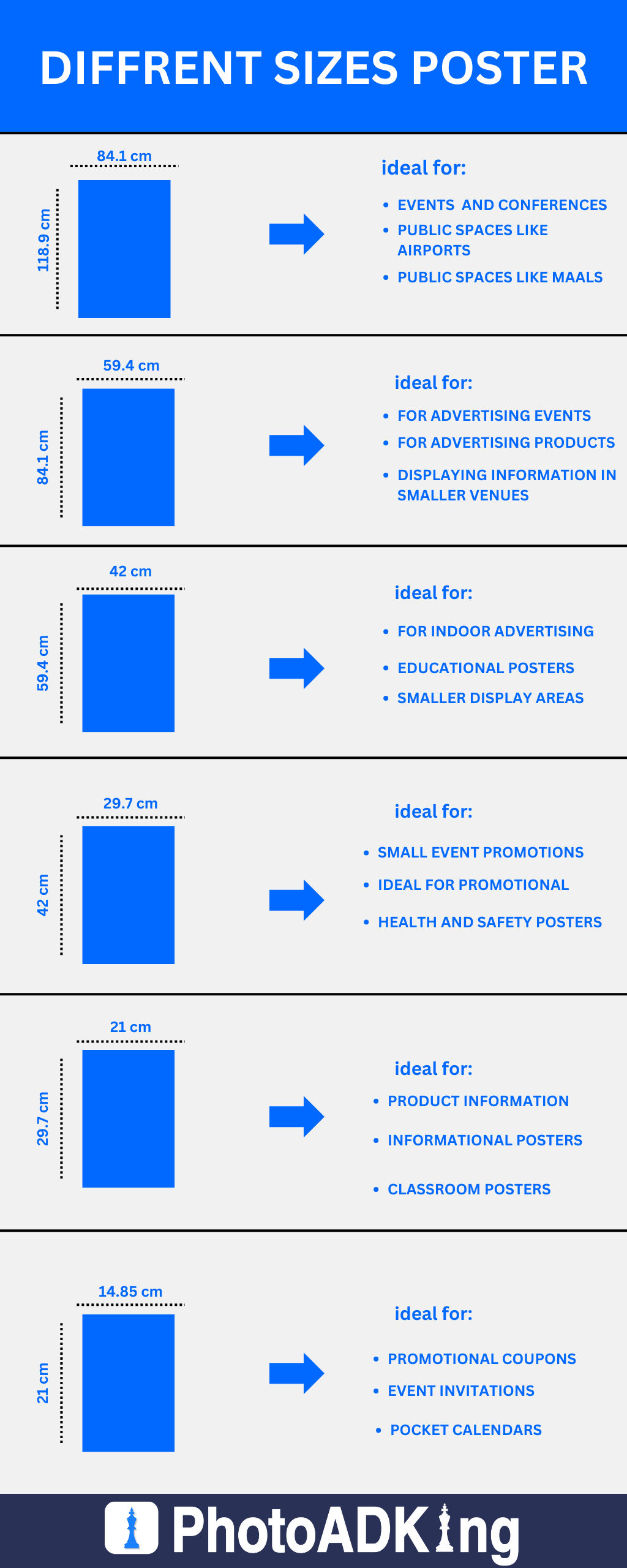
A0 Poster Size: The Large-Scale Choice
- Dimensions: 841 x 1189 mm (33.1 x 46.8 inches)
- Ideal For: Large-format printing, exhibitions, presentations, and any scenario where you need to display detailed graphics or extensive information.
- Usage Tips: Use A0 posters when you want to make a significant visual impact. The large surface area allows for the inclusion of intricate designs and comprehensive data, making it perfect for academic posters, trade show displays, or movie posters.

A1 Poster Size: Ideal for Big Displays
- Dimensions: 594 x 841 mm (23.4 x 33.1 inches)
- Ideal For: Large-scale presentations, displays, promotional materials, and visual content that require more space than standard sizes.
- Usage Tips: A1 posters are suitable for situations where you need to grab attention but don’t have the space for an A0 poster. They are commonly used for advertising campaigns, event promotions, and educational displays.
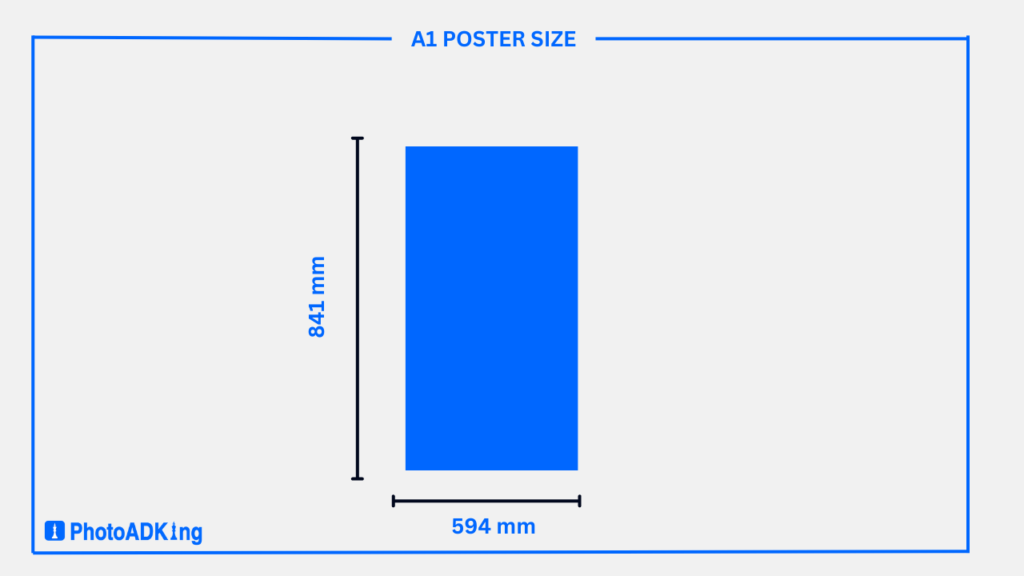
A2 Poster Size: The Versatile Medium
- Dimensions: 420 x 594 mm (16.5 x 23.4 inches)
- Ideal For: Promotional materials, presentations, and artwork that require a balance between size and portability.
- Usage Tips: A2 is a popular choice for posters because it offers enough space for detailed content without being overwhelming. It’s a versatile size that can be used for product displays, event posters, or art prints.

A3 Poster Size: Compact and Effective
- Dimensions: 297 x 420 mm (11.7 x 16.5 inches)
- Ideal For: Smaller promotional materials, informational posters, and decorative prints.
- Usage Tips: A3 posters are commonly used in retail stores, classrooms, and small businesses. They are compact enough to be displayed in limited spaces while still providing enough room for clear, readable content.
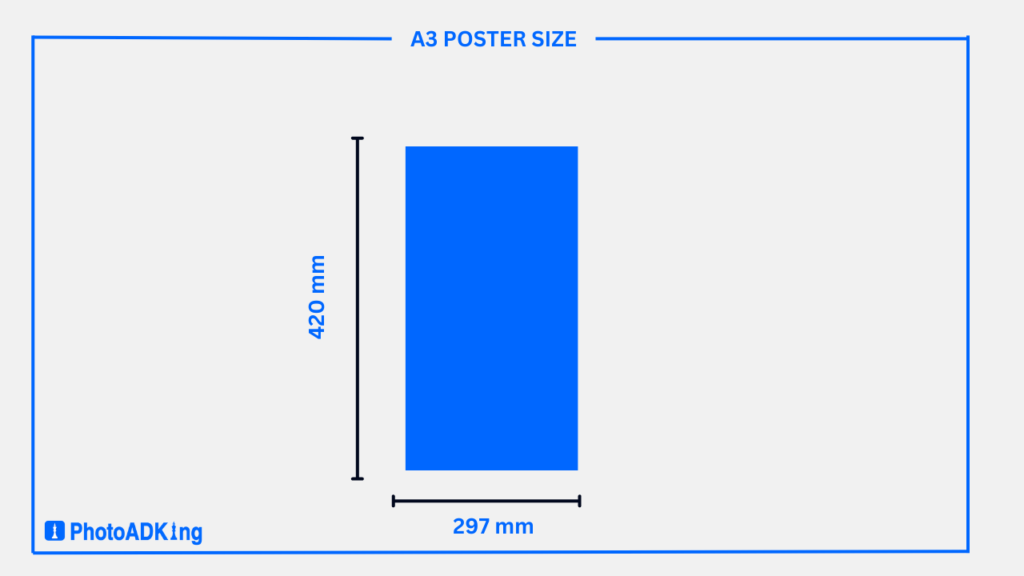
A4 Poster Size: The Everyday Standard
- Dimensions: 210 x 297 mm (8.3 x 11.7 inches)
- Ideal For: Flyers, small posters, notices, and any scenario where space is limited.
- Usage Tips: A4 posters are perfect for everyday use, such as posting announcements, promoting events, or providing information in offices and public places. Their standard size makes them easy to print and distribute.
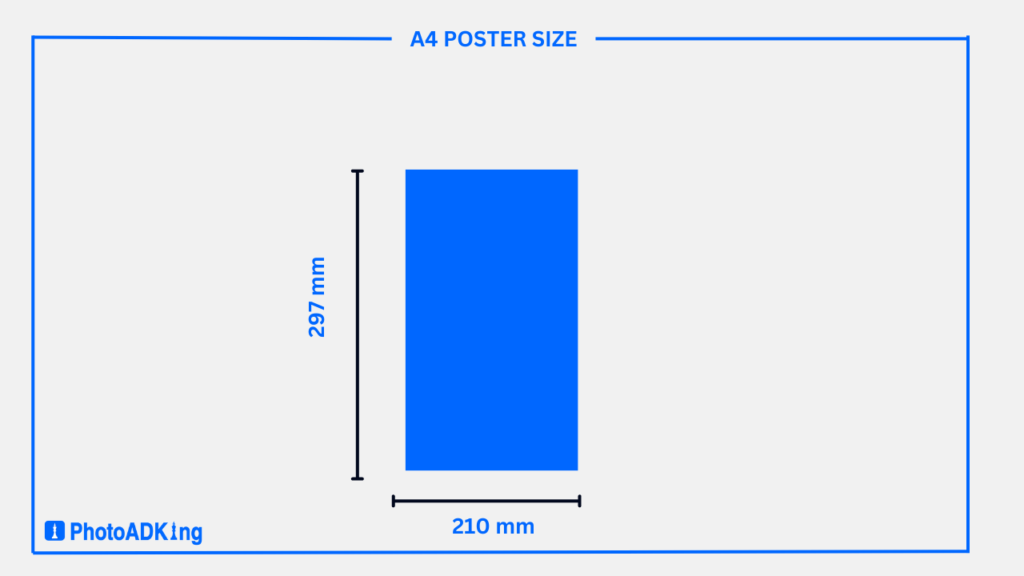
A5 Poster Size: Small but Impactful
- Dimensions: 148 x 210 mm (5.8 x 8.3 inches)
- Ideal For: Event flyers, postcards, small advertisements, and any scenario where concise messaging is required.
- Usage Tips: A5 posters are highly portable and can be used for handouts or small displays. They are often used for event invitations, promotional postcards, and compact advertisements.
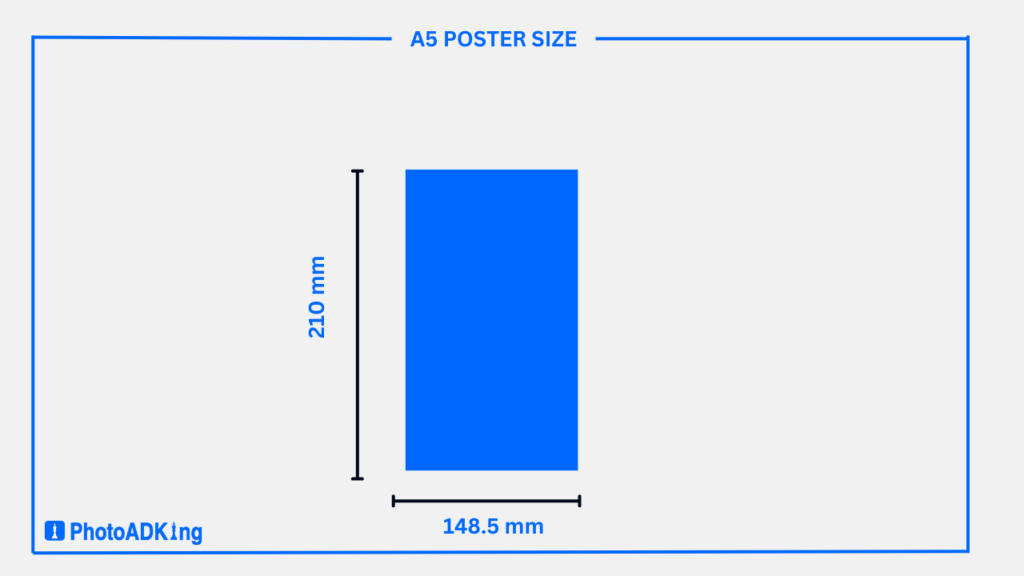
Choosing Between Portrait and Landscape Poster Orientations
The orientation of your poster is just as important as its size. Portrait orientation is taller than it is wide, making it ideal for designs that emphasize vertical elements or textual content. Landscape orientation, on the other hand, is wider than it is tall and is better suited for wide visuals or when you want to create a sense of breadth.

Paper Types for Posters: Which is Best for Your Design?
The type of paper you choose for your poster can greatly affect its look and feel. Here’s a breakdown of the most common paper types used in poster printing:
Matte Paper: Best for Text-Heavy Designs
- Description: Non-reflective surface that reduces glare, making it ideal for detailed designs and text-heavy content.
- Best For: Posters with a lot of information, such as academic posters or infographics.
Glossy Paper: For Vibrant Colors
- Description: Shiny surface that enhances color vibrancy and sharpness.
- Best For: Posters with high-resolution images, vibrant artwork, or promotional content that needs to stand out.
Satin or Semi-Gloss Paper: The Balanced Option
- Description: Offers a compromise between matte and glossy, providing some shine without too much reflection.
- Best For: Versatile use, suitable for a variety of poster types, from artistic displays to promotional content.
Canvas Paper: For an Artistic Touch
- Description: Resembles the texture of canvas material, giving posters a unique and artistic feel.
- Best For: Artistic posters, decorative prints, and any design where a tactile element adds value.
Vinyl or Synthetic Paper: Durable and Weather-Resistant
- Description: Waterproof and tear-resistant, made from synthetic materials like polypropylene.
- Best For: Outdoor posters, and promotional materials that need to withstand the elements.
Poster Design Tips: How to Create Eye-Catching Posters
Creating a successful poster involves more than just choosing the right size and paper. Here are some design tips to help you make the most of your poster:
Visual Hierarchy: Guide the Viewer’s Eye
Establish a clear visual hierarchy by using size, color, and placement to highlight the most important elements of your poster. The title should be the most prominent feature, followed by key information and supporting visuals.
Readable Fonts: Choosing the Right Typeface
Select fonts that are easy to read from a distance. Sans-serif fonts like Arial or Helvetica are often preferred for posters because of their clarity and simplicity. Make sure your text size is appropriate for the viewing distance.
Color Contrast: Making Your Poster Stand Out
High contrast between text and background colors makes your poster more legible and attention-grabbing. Use contrasting colors strategically to highlight important information and create visual interest.
Using Whitespace: Avoiding Overcrowded Designs
Whitespace, or negative space, is crucial for preventing your poster from looking cluttered. It helps separate elements, making your design more organized and easier to read.
Incorporating Visual Elements: Enhancing the Message
Use images, icons, and illustrations to support your message. Visual elements should complement your text, not overpower it. Ensure that any images used are high-resolution and relevant to the content.
Best Practices for Poster Printing
Even the best-designed poster can be ruined by poor printing. Follow these best practices to ensure your poster looks as good in print as it does on screen:
Resolution: Ensuring Clear and Crisp Prints
For large posters, ensure your images and graphics are at least 300 DPI (dots per inch) to avoid pixelation. Lower resolutions may look fine on screen but will appear blurry when printed at a larger size.
Bleed and Margins: Avoiding Common Pitfalls
Include a bleed area in your design to account for any cutting discrepancies during printing. A standard bleed is usually 3mm. Additionally, keep important content away from the edges of the poster to prevent it from being trimmed off.
File Formats: Choosing the Right One for Printing
Save your final design in a high-quality format such as PDF, TIFF, or EPS. Avoid using low-resolution formats like JPEG, which can compress the image and reduce print quality.
Using PhotoADKing’s Poster Maker for All Poster Sizes
Creating posters of any size is easy with PhotoADKing’s Poster Maker. Our tool offers a wide range of customizable templates, allowing you to design posters that perfectly fit your needs. Here’s a step-by-step guide:
Step-by-Step Guide to Creating Posters
- Choose a Template: Start by selecting a template that matches the size and purpose of your poster.
- Customize the Design: Use PhotoADKing’s intuitive tools to add text, images, and other elements. Adjust colors, fonts, and layouts to suit your brand or message.
- Preview Your Design: Ensure everything looks perfect by previewing your design in various sizes and orientations.
- Download and Print: Once satisfied, download your poster in the desired format and print it using your preferred paper type.
Conclusion
Choosing the right poster size is essential for effectively communicating your message. By understanding standard dimensions, selecting the appropriate paper, and following best practices in design and printing, you can create posters that are visually appealing and impactful. Use PhotoADKing’s Poster Maker to simplify the process and bring your creative vision to life, no matter the size.











